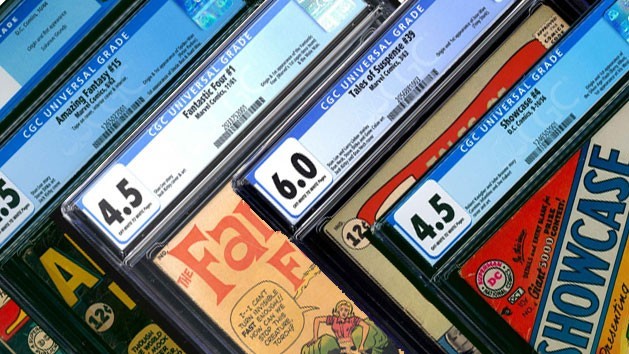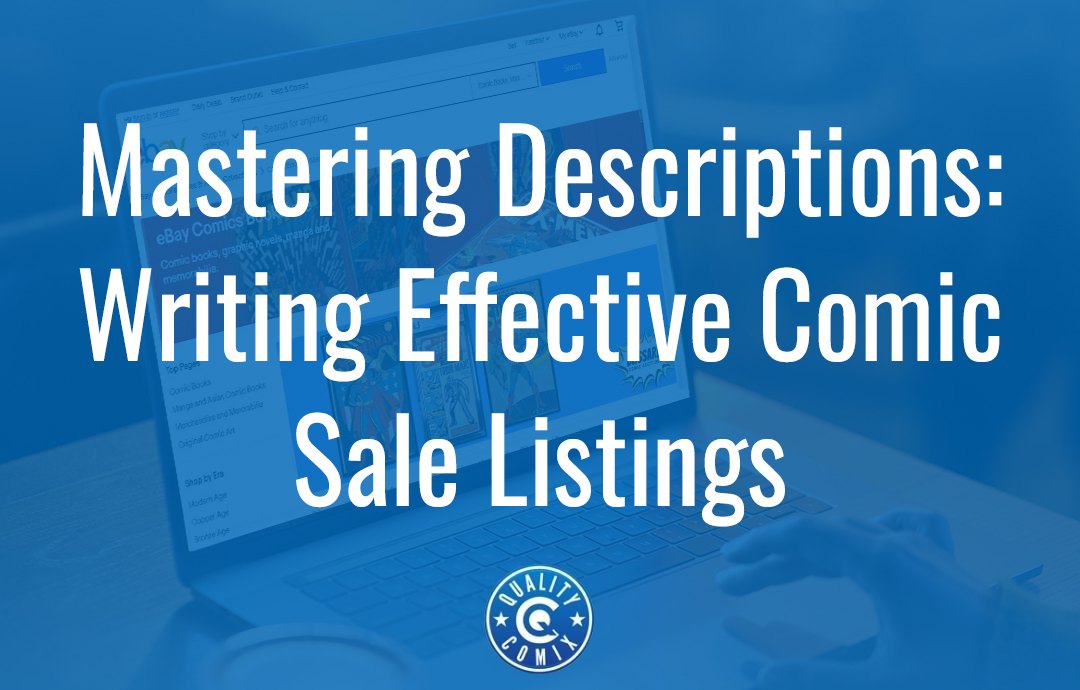
When you want to sell comics online, you have to put some effort into it; otherwise, you're going to see very low interest. This is especially relevant for auctions, where low interest means low prices, and you might struggle to even find a buyer for less desirable comics.
Online auction listings can be broken down into a handful of elements. Photos are one, titles are another, but the one we're most interested in today is descriptions. What goes into a good comic description? How can you optimize the chances of your comic being seen, bid on, and sold? Here are our top tips.
Table of Contents
Basic Tips and Information
When writing a description for your comic, there are a few general tips to keep in mind.
The first, and perhaps most important of them, is to keep it short. Longer descriptions give you more room to use keywords for SEO purposes, but on sites like eBay, you aren't generally going to be worried about SEO. All of the technical details of the comic will have that covered.
Instead, your text description should be mostly just a paragraph or two of anything noteworthy or relevant about the comic. You don't need to go all the way into full comic-ese and emulate Stan Lee in your description. It comes across as cheesy and can, in some cases, get in the way of what people really want to know.
To prose or not to prose? Truthfully, this is something of a personal decision and can come down to how you want your brand to be positioned in the comic vendor space. Some list so many comics so frequently that anything more than the bare technical details is just way too much work. Others try to set themselves apart by telling a story about the comic. As long as you have all of the relevant technical details and your narrative isn't getting in the way or hiding important details, you can do whichever you prefer.
Another key tip is that, even if you have important details in the title of your listing, you want them listed in the description as well. Don't slack off just because the information is in one place already.

Another choice you can make is whether you want to format your description. There are generally four styles we've seen on eBay.
- Next to nothing. These listings rely on the title and the item info box to deliver the details and put basically nothing in the description box. Here's an example. We don't recommend this. It's too bare-bones and doesn't include enough information to capture as much attention as you would want.
- Simple, plain text. Short, to the point, no formatting, no gimmicks, no cross-sells with other comics on the same store. These are the easiest to manage because you don't need to mess with code or formatting or fetch links from other listings or anything of the sort. However, it's also the least interesting. Here's an example.
- Text with basic formatting. This will use bolding, headlines, and occasionally even colors to stand out and point out specific information. There's still nothing tricky about it, but it's a little more robust than others. You really benefit from templates from these, but they can potentially speed up your listing process. Here's an example. Here's a more elaborate example using colors to stand out.
- More advanced formatting. These tend to use things like tables to showcase specific information, like all of the critical details of the publisher, author, issue, line, characters, grading, and so forth. Here's a simple example. Here's a much more elaborate example with full code widgets to include related sales from the same store.
Now, you don't need to go fully elaborate with widgets and store boxes unless you plan to sell large volumes of comics on a consistent basis and want to have as much throughput as possible. At that point, you can develop a whole template and process, or even automate it, or hire someone to handle your listings for you.
Don't forget to take good photos!
Don't be afraid to edit to add more information, especially if someone asks you a question, even if that question doesn't result in a sale. Having the information in the listing can minimize additional questions, and trust us, by the time you've gotten the same question a dozen times, you'll be tired of answering it.
Finally, make sure you proofread and double-check everything you write. Typos and mistakes can cause problems ranging from people not viewing you as professional enough to be trusted as a seller to people thinking you're deliberately misrepresenting what you're selling, even if you aren't. Even something as simple as the formatting for line breaks should be tested, especially if you include more elaborate things like code and widgets; those might not display properly on every device, and you want to make sure they do. When in doubt, simplify.
What Should You Include?
The biggest question you're probably asking yourself is what information you should include in the listing. In our view, the answer is "as much as possible." Everything that could potentially attract someone to the comic should be listed.
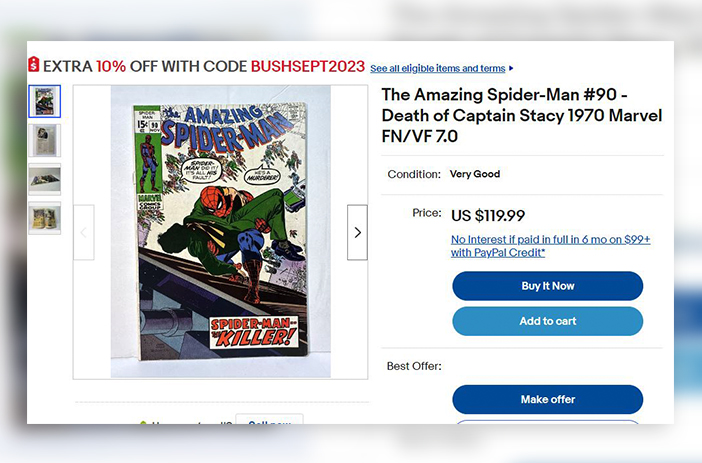
Image source: eBay Listing
In general, here's what to list:
- Name of the book, such as "Amazing Spider-Man". The specific title can be surprisingly important when there are so many similar comics out there.
- Issue number. In cases where a comic might have issue and volume numbers, include both.
- Year of publication. Also include the year of the line, if necessary.
- Artists and writers involved.
- Publisher. Sometimes, it's obvious, but this can be more relevant for indie comics.
- Era, though publication date can cover this somewhat.
There are also all sorts of additional details you can include, such as:
- Information about storylines. This can be especially relevant for golden-age comics, where a single issue would have multiple mini-stories with their own titles.
- Characters involved, outside of the title characters, for the collectors who want everything to do with someone specific.
- Grading information. Is the comic graded, and if so, which company did the grading, what is the grade, what label does it have, what is the serial number, does it have any qualifications, is it a part of a pedigree, and so on.
- Condition, and notes about the said condition. This is especially relevant for comics that aren't graded; how is the ink and paper quality, what grade would you estimate it is, and is it complete?
- Completeness. For comics that had cut-away coupons, mail-in inserts, posters, or other additional media, those add-ons can be valuable. Does yours have them or not, and in what condition?
- Storage. If the comic is graded, obviously, it's slabbed. If it's not graded, how is it stored? Do you have it in a folio, in a bag and board, in a binder? There are all kinds of comic storage methods, and people might want to know about it.
- Relevance to pop culture. Pay attention to movies and TV; are there any new media coming out for the comic? Comics that have an extra interest because the storyline in them is being produced into new media can sell for a premium, but only if people know.
Finally, if you have specific policies or details that the buyer may find relevant, include those as well. For example, if you have shipping options, you may want to explain them, along with how long they might take. You might also want to explain any additional fees that could crop up, your policy on returns, insurance, communication, tracking numbers, and so on. A lot of this can depend on whether you're selling casually as a collector or professionally as a business, too.
Identifying and Explaining Variant Information
Another detail that can be very relevant is the variant information for a comic. There are a lot of different kinds of variants, and they can come up in different ways, including both intentional and unintentional variants. Sometimes, they're hard to identify; other times, they're a lot more obvious or even clearly identified by the cover or barcode. Here are some resources you can use to learn more.
- Our guide to Error Variants and their values.
- Our guide to comic UPCs and how to read them.
- A rundown of Ratio Variants and what they mean.
- A description of newsstand versus direct editions and how to identify them.
In general, if your comic is an issue that has variants, it can be worthwhile to know that so you know whether or not yours is a variant and which one it is if there is more than one.
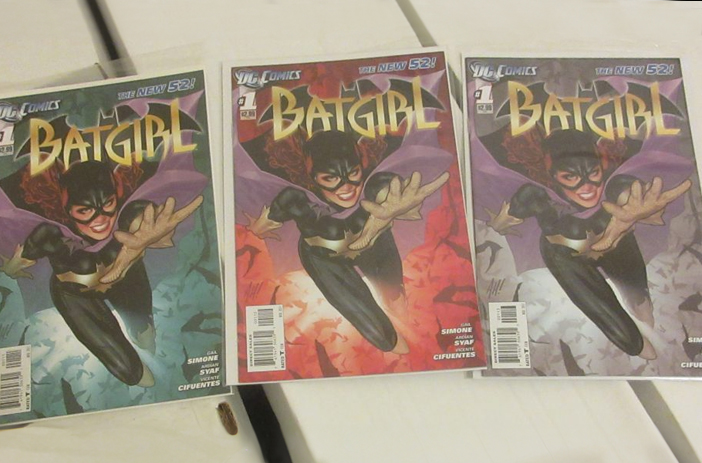
Identifying variants can be a huge detail when it comes to getting the most value out of your comics. If your comic is one of the more rare or valuable variants, letting people know that – as well as explaining what the variant is and what it means – can be a key part of a good description.
It can be helpful, especially to causal collectors, to explain how rare the variant might be. A 50/50 variant printing means one isn't likely to be more valuable than the other. An error variant where only a few dozen are known and most were destroyed could be very valuable to the right collector, but not everyone wants error variants. A ratio variant usually has some degree of scarcity, often artificial, and can make it more valuable. All of these details can be very important.
Pedigree and Provenance
Sometimes, a comic isn't terribly valuable on its own, but it can be made more valuable because of where it came from. The most common examples of this are pedigree collections, which are particularly noteworthy collections of comics all from a single source. CGC recognizes 61 different pedigree collections at the moment, though there may be more out there waiting to be discovered.
Provenance is a term for where a comic came from and who has owned it in the past. One issue of a comic might be more or less identical to another, but if one was from the private collection of a celebrity, some people might be interested in paying slightly more for it.
Provenance is only important if you can provide some kind of proof or contact to allow the buyer to prove it themselves, though. Saying, "This comic was owned by Michael Jackson!" doesn't really mean anything if there's no way to prove it and there's nothing noteworthy about it.
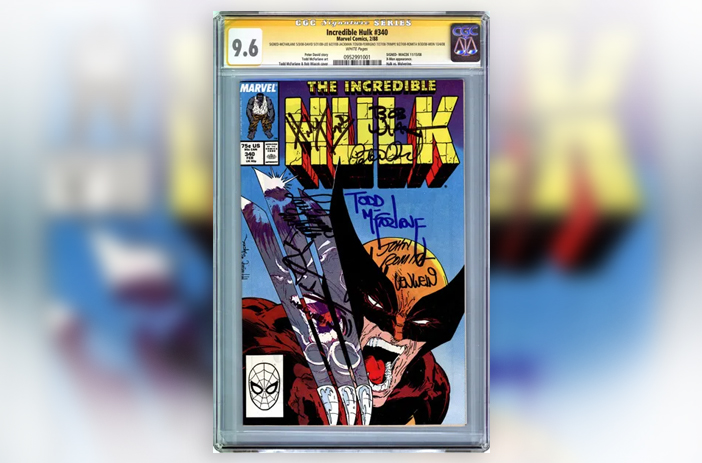
One area where provenance can be important is signatures, both of the people involved in the comic (character creators, artists, writers, and greats like Stan Lee) and in terms of other famous people (celebrities who played the character, for example.)
Traditionally, CGC only recognizes signatures as valid if they were signed in the presence of a CGC official. This is because signatures are pretty hard to evaluate and distressingly easy to copy, so there would be a lot of potential for fraud otherwise.
Include this information if it's relevant and you have it; otherwise, it probably doesn't matter enough to be worth mentioning.
Skip the Hassle
Finally, you can always skip the hassle entirely. One of the best ways to do so is to take a few photos of your comics or your collection as a whole, write down a general description of what you have, and head on over to fill out this form. As one of the foremost vendors of high-end comics, we're deeply experienced in all things comic sales, from the identification and evaluation to the actual sales and fulfillment.

That means if you're interested in selling your comics to us, we're more than happy to discuss what you have and what you might be able to get for them. Even if you're not sure you want to sell right away, we're happy to talk about your collection, give you a basic appraisal, and offer you advice on how you can proceed with selling it. There's no cost and no obligation, either; we're not pushy. We just love comics and want to help you out, whether you're selling an inherited collection or trying to kick off a comic resale business.



